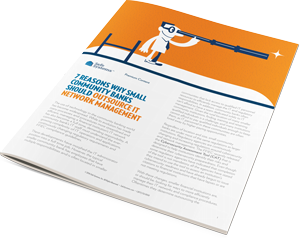Reduce the Stress of Your Bank’s IT Exams

Financial institutions are governed by stringent regulations, including strict guidelines for the institution’s information security program. Institutions must undergo regular audits, both internal and external, to help ensure their control environment is sound and compliant. These audits ultimately help the institution prepare for when the examiners come knocking. Regulatory agencies conduct these IT exams to determine if the institution’s policies and procedures are sound, and if daily practices are in line with those standards. Rarely are these experiences fun or care-free.
The IT audit and examination processes can both be very time consuming and stressful for security officers, IT Administrators, and the institution’s executives. IT audits, while invaluable, may result in a laundry list of suggested improvements, most of which come with a price tag. Senior management must decide which suggestions are worth the investment and which constitute acceptable risk. Then, they must be able to defend that position to examiners.
Recent developments, including the FDIC’s introduction of the Information Technology Risk Examination (InTREx) Program, emphasize that it is not enough to have a solid Information Security Policy and procedures. Today’s examiners are requiring ever-increasing amounts of documentation as evidence that your institution is indeed doing what your policies and procedures promise. Financial institution IT professionals, already tasked with the full-time job of keeping systems up and running, are also asked to help the Information Security Officer gather volumes of documentation that make up this paper trail.
Without help, this regulatory burden can be a major challenge for smaller community banks and credit unions that lack the resources and experience to adequately meet ever-growing regulatory demands. However, there are some steps these smaller institutions can take to ease the stresses associated with this near-constant scrutiny.
Be Proactive – Conduct IT Self-assessments
To help ensure better results on bank IT audits and examinations, all financial institutions should complete periodic (quarterly) control self-assessments that enable management to gauge the state of IT performance, system status, and emerging risks. These proactive IT self-assessments are essential for ongoing monitoring of security controls and ensuring prompt corrective action of significant deficiencies. These regular reviews are not just beneficial, they are also mandatory. FFIEC guidance dictates that financial institutions perform regular self-assessments to “validate the adequacy and effectiveness of the control environment.”
At Safe Systems our strategic advisors work with each client to perform quarterly technology self-assessments. While this assessment helps the institution ensure all things related to IT network technology controls are working and up to date, it also serves as time for the strategic advisor to educate bank personnel on new or changing government regulations. This helps the bank to remain in compliance and sets the institution up for success in audits and exams.
Auditor feedback from our clients indicates that financial institutions that work with experienced IT outsourcing vendors and have an effective internal self-assessment process in place generally demonstrate a much more evolved risk management process and have a smoother IT audit. Simply put, this results in fewer, and less severe, audit findings. These institutions tend to identify, correct and control weaknesses prior to an audit, as opposed to waiting for the auditor to identify them. Since one of the first things the examiner wants to see when they arrive is the most recent IT audit, this often results in fewer examination findings as well.
7 Reasons Why Small Community Banks Should Outsource IT Network Management
This is a free white paper that addresses key issues smaller financial institutions face when managing their networks and the benefits of outsourcing these tasks.

Automate Reporting for IT Examinations
Documentation and reporting make up the paper trail that examiners are looking for to help validate your information security program. Being able to provide comprehensive reports that are easy-to-understand and provide clear and concise summary information is vital to any IT audit or exam. You may be asked for documentation on who is involved in technology reviews, frequency of meetings, minutes from each meeting, IT issues the bank is addressing, technology inventory management, patch management reports, testing policies and procedures, and disaster recovery plans, to name a few. These reports can be a time-consuming hassle to generate. However, with a financial institution specific reporting solution in place that automates the process and provides detailed on-demand reports, financial institutions can easily generate much of the appropriate documentation in a time efficient manner.
Preparing for an IT audit or exam can certainly be a headache! However, working with Safe Systems can provide your bank with peace of mind because by the time the examiner gets there, you are well prepared and can feel confident of the upcoming exam result. Safe Systems provides financial institutions with a trusted resource and technology advisor, leading to improved IT audit and examination ratings. With an experienced IT services provider, bankers can get back to the business of banking while compliance-oriented IT professionals work to ensure network components, servers and workstations are operating properly and securely; all while helping to ensure that your institution is meeting regulatory requirements.


